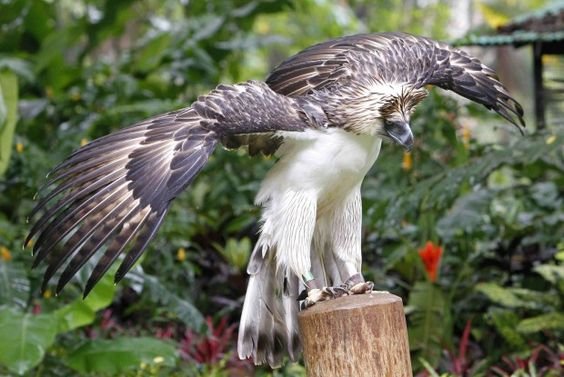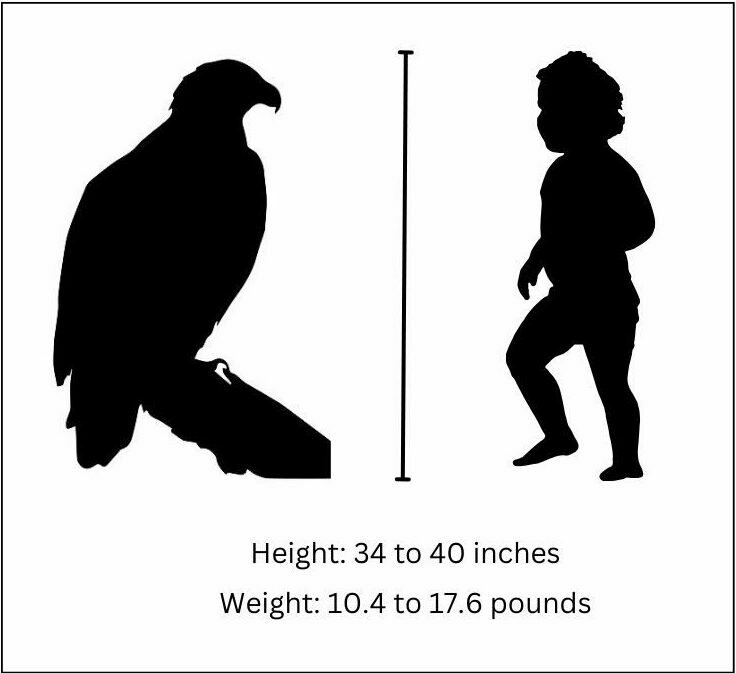The Philippine Eagle, also known as the Monkey-eating Eagle, is not only a sight to behold but also a vital component of its habitat. Recognized as the largest eagle globally, it commands the skies of the Philippine rainforests, embodying both grace and might. In this article, we delve into the fascinating world of this majestic bird, exploring its characteristics, habitat, and the crucial role it plays in the ecosystem. Join us as we unfold the story of the the Largest Eagle in the World.
The Largest Eagle in the World
How Big is a Philippine Eagle?
To truly grasp the grandeur of the Philippine Eagle, it’s essential to draw comparisons with objects and animals we encounter in our daily lives. Let’s embark on a journey to visualize the sheer size and majesty of this magnificent bird.
Wingspan

The wingspan of a Philippine Eagle is a staggering 2.2 meters (7.3 feet), which is roughly equivalent to the length of a standard sedan car. To put it in another perspective, it’s almost the same as the height of a fully grown giraffe! When you spread your arms wide, you might cover a space of about 1.5 to 1.8 meters, which means the eagle’s wingspan exceeds the arm span of an average adult human by quite a margin.
Body Size and Weight

In terms of body size, the Philippine Eagle stands tall with a height ranging from 86 to 102 centimeters (34 to 40 inches). This means, if perched, it would be almost as tall as a toddler standing upright. Weighing in at about 4.7 to 8 kilograms (10.4 to 17.6 pounds), it’s as heavy as carrying around two to four average-sized housecats.
Beak and Talons

The beak of the Philippine Eagle is a formidable tool, robust and hooked, measuring about 7.4 centimeters (2.9 inches) in length. To visualize this, think of a standard credit card, which is about 8.5 centimeters long; the beak would be just slightly shorter than that. Its talons are equally impressive, with a length of up to 12.7 centimeters (5 inches), which is comparable to the length of a human hand from wrist to the tip of the middle finger. These talons are designed to grasp and tear apart prey with a grip strength that far surpasses that of a human hand.
Feathers and Crest

The Philippine Eagle is adorned with a distinctive crest of long brown and white feathers that forms a shaggy mane. This crest, which can be raised or lowered, adds to its regal appearance, making it look even larger and more majestic when fully displayed. It’s akin to a crown that signifies its royal status in the avian world.
Comparing the Size of the Philippine Eagle with the Top 5 Largest Eagles
1. Philippine Eagle (Pithecophaga jefferyi)
- Wingspan: Up to 2.2 meters (7.3 feet)
- Weight: 4.7 to 8 kilograms (10.4 to 17.6 pounds)
- Height: 86 to 102 centimeters (34 to 40 inches)
2. Steller’s Sea Eagle (Haliaeetus pelagicus)
- Wingspan: 2.13 to 2.45 meters (7 to 8 feet)
- Weight: 5 to 9 kilograms (11 to 20 pounds)
- Height: 85 to 105 centimeters (33 to 41 inches)
Comparison: The Steller’s Sea Eagle has a slightly wider wingspan compared to the Philippine Eagle, and they are quite similar in terms of weight and height, showcasing the grandeur of these top predators of the sky.
3. Harpy Eagle (Harpia harpyja)
- Wingspan: 1.76 to 2.24 meters (5.8 to 7.4 feet)
- Weight: 4 to 9 kilograms (8.8 to 19.8 pounds)
- Height: 89 to 105 centimeters (35 to 41 inches)
Comparison: The Harpy Eagle, with a wingspan and height comparable to the Philippine Eagle, is another giant in the eagle family. Their weights are also in the same range, indicating a similar majestic presence in their respective habitats.
4. White-tailed Eagle (Haliaeetus albicilla)
- Wingspan: 1.78 to 2.45 meters (5.8 to 8 feet)
- Weight: 3.1 to 6.9 kilograms (6.8 to 15.2 pounds)
- Height: 66 to 94 centimeters (26 to 37 inches)
Comparison: The White-tailed Eagle can have a wingspan that rivals or even exceeds that of the Philippine Eagle. However, it generally weighs less and is shorter, indicating a slightly smaller body structure.
5. Bald Eagle (Haliaeetus leucocephalus)
- Wingspan: 1.8 to 2.3 meters (5.9 to 7.5 feet)
- Weight: 3 to 6.3 kilograms (6.6 to 13.9 pounds)
- Height: 70 to 102 centimeters (28 to 40 inches)
Comparison: The Bald Eagle, a symbol of strength and freedom in the United States, has a wingspan and height that can be compared to the Philippine Eagle. However, it is generally lighter in weight, showcasing a slightly leaner physique.
Scientific Classification
The Philippine Eagle, scientifically known as Pithecophaga jefferyi, belongs to the family Accipitridae. This name, which translates to “monkey-eating hawk,” hints at its predatory nature and primary diet.
Habitat
The Philippine Eagle is endemic to the Philippines, meaning it is found nowhere else on Earth. It primarily resides in the lush rainforests of the islands, particularly in Luzon, Samar, Leyte, and Mindanao. These regions provide the perfect environment for this majestic bird, offering a rich biodiversity that supports its diet and nesting habits. Unfortunately, the eagle’s habitat is under threat due to deforestation and habitat fragmentation, which has led to its status as a critically endangered species.
Diet and Hunting Techniques
The Philippine Eagle, a top predator in its habitat, primarily feeds on medium-sized mammals such as monkeys, flying squirrels, and bats. It is equipped with excellent vision, allowing it to spot potential prey from a great distance. When hunting, it utilizes a “sit-and-wait” technique, perching silently on a tree branch and swooping down swiftly once it spots its prey. Its powerful talons and strong beak enable it to grasp and tear apart its prey with remarkable efficiency.
Reproduction and Lifespan
The breeding season of the Philippine Eagle is quite prolonged, spanning from July to February. These monogamous birds form lifelong bonds with their partners. The female lays a single egg every two years, and both parents take turns incubating it for about 58 to 60 days. After hatching, the young eagle is nurtured and fed by both parents for a considerable period, usually around 17 to 18 months. In terms of lifespan, the Philippine Eagle can live up to 40 to 60 years in the wild, a testament to its resilient nature.
Role in the Ecosystem
As a top predator, the Philippine Eagle plays a vital role in maintaining the balance in its ecosystem. By controlling the population of smaller animals and rodents, it helps to prevent overgrazing and promotes healthy forest regeneration. Its presence is often an indicator of a healthy and thriving ecosystem, as it requires a vast territory with rich biodiversity to survive. Unfortunately, the loss of habitat and hunting pressures are threatening its existence, which in turn impacts the overall health and balance of the ecosystems it inhabits. Conservation efforts are thus crucial to preserve not only the eagle but the intricate web of life in the Philippine rainforests.






Leave a Reply